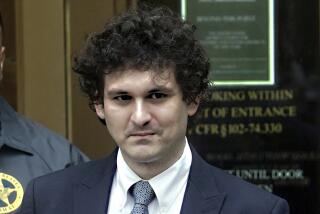Legal on the Outside, Scam on the Inside
- Share via
Because of the F. D. Roberts Securities case, investigators are getting a unique opportunity to see how a typical penny stock scam is put together. And what they are finding is enlightening: The people who operated F. D. Roberts were on the up-and-up in their handling of prospectuses and other documents that went to the Securities and Exchange Commission. But they were anything but truthful with the public.
“They went through all the motions,” said one investigator familiar with the case. The only trouble was that “very few people who invested ever got a prospectus,” he adds.
The only things that investors got were slick sales pitches, some high-pressure sales tactics, maybe a deceptive brochure and a lot of lies. Even the most naive investor probably wouldn’t have sent F. D. Roberts a dime if he or she had seen what the brokerage firm was telling the SEC.
Take Innovative Business Corp. as an example.
Through F. D. Roberts, the company sold to the public 2,000 units--with each unit consisting of 10,000 shares of company stock plus 10,000 common stock purchase warrants. Each unit was priced at $500--making the total offering worth $1 million.
F. D. Roberts took a generous 10% fee from the money raised. And of the $900,000 earmarked for the company--which was supposed to be in the market for corporate acquisitions--another $100,000 would be gobbled up by expenses.
That left Innovative Business with $800,000, which the prospectus clearly stated “may not be sufficient to complete one acquisition.”
Prosecutors said they don’t believe that Innovative Business ever made an acquisition. But the company’s stock, they said, still rose shortly after the initial public offering. And F. D. Roberts made a fortune.
Integrated Business Corp. was an even crazier scheme.
Its prospectus said the company had obtained an option to acquire a franchise from the U.S. Basketball League Inc. to operate a team in Tampa, Fla. Through F. D. Roberts, the company sold 12.5 million units at 2 cents each. Of the $250,000 raised, the prospectus said, only $210,000 would probably go to the company. And $30,000, or 13.5% of the total proceeds, would go to pay company executives.
But that wasn’t the worst part. The prospectus also stated that there were already 32.5 million shares outstanding--presumably held by company insiders who cooked up the scheme.
That meant that as soon as the initial offering was completed, the value of the units being sold to the public would automatically decline from the original 2 cents to half a cent.
Even so, through market manipulation on the part of F. D. Roberts, the company’s virtually worthless shares were being quoted at prices far exceeding the level of the initial public offering, prosecutors said.
But F. D. Roberts wasn’t content just to make a sizable fee from taking these companies public. The companies typically would have friends and relatives of F. D. Roberts officials in top positions, drawing nice salaries.
Prosecutors have also charged that F. D. Roberts and its brokers reaped huge commissions by trading excessively in clients’ accounts. And, in manipulating the price of these stocks higher, F. D. Roberts was guaranteeing itself a bundle since Roberts officials have also been charged with illegally purchasing shares for themselves.
F. D. Roberts, moreover, made it very difficult for the public to sell its stock. F. D. Roberts officials, their friends and relatives, on the other hand, had no trouble selling their stock holdings, officials said. This essentially created a pyramid scheme in which only a chosen few could capitalize on the manipulation of a stock’s price.
Additionally, F. D. Roberts was in the habit of granting to itself, at virtually no cost, warrants to purchase shares in most of the companies that it took public. This gave F. D. Roberts yet another way to cash in on its manipulation.
More to Read
Inside the business of entertainment
The Wide Shot brings you news, analysis and insights on everything from streaming wars to production — and what it all means for the future.
You may occasionally receive promotional content from the Los Angeles Times.










